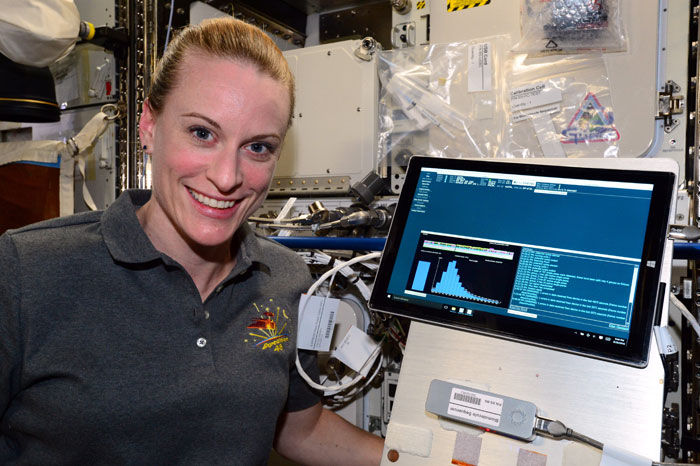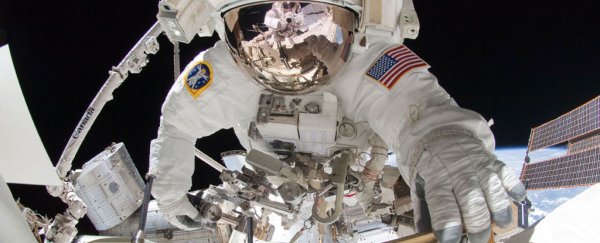Scientists have sequenced DNA in space for the first time ever, with NASA astronaut Kate Rubins taking part in a pioneering experiment on board the International Space Station (ISS) over the weekend.
Rubins, who's also a molecular biologist, ran the first successful tests of a mobile DNA sequencer in a microgravity environment – using a tool that could be vital in protecting the health of astronauts on future missions in space, or even to identify alien life forms.
The portable sequencer – called MinION – was developed by UK-based Oxford Nanopore Technologies, and allows researchers to identify an organism's DNA sequence using a technique called nanopore sequencing.
In nanopore sequencing, an electric current is sent through tiny pores in cell membranes to pick up changes in ion flow as DNA molecules pass through the nanopores. These changes can then be used to decode the sample's DNA sequence.
In addition to being small and readily portable – the whole MinION is only about the size of a chocolate bar – the device is also quick, and can run sequencing in as little as 10 minutes.
But while scientists use portable DNA sequencers in the field to track the outbreak of viruses like Ebola and Zika, nobody knew until now if the same technology would work in space.
One potential hurdle was the possibility that the way bubbles behave in a microgravity environment could have interfered with the liquid samples used in the testing.
"In space, if an air bubble is introduced, we don't know how it will behave," said NASA planetary scientist Aaron Burton. "Our biggest concern is that it could block the nanopores."
Another challenge was actually getting DNA sequencers into space, and ensuring that delicate components in the equipment survive the trip undamaged.
Fortunately, Rubin's successful experiment on the weekend showed that the scientists needn't have worried. The astronaut used the MinION to sequence samples of mouse, bacteria, and virus DNA on board the ISS, then transmitted the analysis to Earth.
A team of scientists led by the University of California, San Francisco (UCSF) analysed the data sent from the ISS, and compared it to identical samples sequenced in the lab on Earth. The results matched up, showing that microgravity isn't a barrier to identifying the unique building blocks that make up organic lifeforms.
"It didn't turn out to be a huge problem," said microbiologist Charles Chiu from UCSF. "We essentially got equivalent data, and it's of very high quality, probably within the top 20 percent of nanopore runs that we do routinely here on Earth."
 Kate Rubins, with the MinION. Credit: NASA
Kate Rubins, with the MinION. Credit: NASA
Now that we know that conditions in space are suitable to DNA sequencing, astronauts will be able to analyse any bacteria or organisms they come across on board the ISS, or during long-term missions across the Solar System.
In most cases, that would be biological material they've brought aboard with them, but identifying things like fungi in space could be vital to maintaining astronaut health.
"Onboard sequencing makes it possible for the crew to know what is in their environment at any time," said NASA microbiologist Sarah Castro-Wallace. "That allows us on the ground to take appropriate action – do we need to clean this up right away, or will taking antibiotics help or not?"
"We can resupply the station with disinfectants and antibiotics now," she added, "but once crews move beyond the station's low Earth orbit, we need to know when to save those precious resources and when to use them."
Looking a little further down the line, the same technology is what would also enable astronauts to identify any potential alien life forms or organic material we stumble across while exploring space.
"For all the reasons the sequencer is good for microbiology applications –it's small, it's lightweight, pretty robust – it's a good piece of equipment to send to other locations in the Solar System," Burton told Ria Misra at Gizmodo back in July.
"So if you wanted to go to Mars and see if there was life, if you had a small sequencer device, you could take it with you, and you could actually start looking for life."
Because, after all, if there's anything that science-fiction movies have taught us, it's that you don't want to send unidentified alien samples back to the home planet for analysis.
It never ends well when you do.
